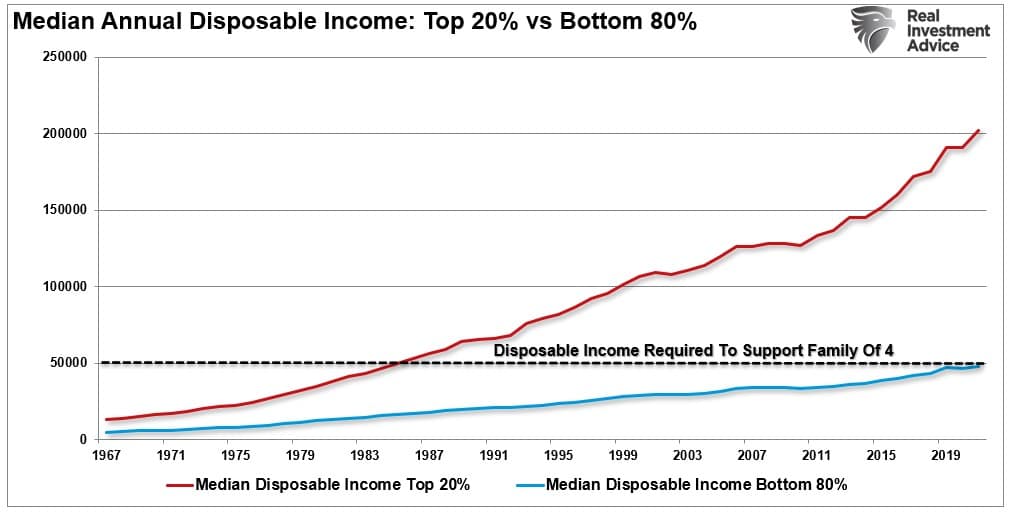Recently, Paul Tudor Jones made headlines stating that the #debt and #deficits would lead the U.S. into #bankruptcy. As such, he would not own #Government #bonds. We look at the data to see if it supports his claims.
realinvestmentadvice.com/resources/blog…
realinvestmentadvice.com/resources/blog…
The chart below shows the long-term view of short and long-bond interest rates, inflation, and GDP.
Interest rates rose during three previous periods in history.
1-During the economic/inflationary spike in the early 1860s
2-The “Golden Age” from 1900-1929 saw inflation rise as economic growth resulted from the Industrial Revolution.
3-The most recent period was the prolonged manufacturing cycle in the 1950s and 1960s. That cycle followed the end of WWII when the U.S. was the global manufacturing epicenter.
-The current surge in #inflation, and ultimately interest #rates, was not a function of organic #economic growth. It was a stimulus-driven surge in the supply/demand equation following the pandemic-driven shutdown.
realinvestmentadvice.com/resources/blog…
Interest rates rose during three previous periods in history.
1-During the economic/inflationary spike in the early 1860s
2-The “Golden Age” from 1900-1929 saw inflation rise as economic growth resulted from the Industrial Revolution.
3-The most recent period was the prolonged manufacturing cycle in the 1950s and 1960s. That cycle followed the end of WWII when the U.S. was the global manufacturing epicenter.
-The current surge in #inflation, and ultimately interest #rates, was not a function of organic #economic growth. It was a stimulus-driven surge in the supply/demand equation following the pandemic-driven shutdown.
realinvestmentadvice.com/resources/blog…

As those #monetary and #fiscal inflows from the #pandemic spending reverse, that support will fade. In the future, we must understand the factors that drive rates over time: #economic growth, #wages, and #inflation. Visually, we can create a composite index of GDP, wages, and inflation versus interest rates.
realinvestmentadvice.com/resources/blog…
realinvestmentadvice.com/resources/blog…

Rising #government #debt has not correlated with higher interest #rates over the past few decades. Since 1980, total U.S. debt as a share of GDP has surged from 156% to nearly 353%. However, economic #growth and interest rates slowed during that period.
Despite increasing debt, slower economic growth reflects the diversion of productive capital into non-productive debt service. In other words, debt is “#deflationary” as it retards economic prosperity.
realinvestmentadvice.com/resources/blog…
Despite increasing debt, slower economic growth reflects the diversion of productive capital into non-productive debt service. In other words, debt is “#deflationary” as it retards economic prosperity.
realinvestmentadvice.com/resources/blog…

Furthermore, Jones’ example of the “#Japan #experience” with #debt fails to support his concerns. In Japan, high debt levels did not lead to runaway inflation or surging interest rates. Despite a 250% debt-to-GDP ratio, Japan faced persistent deflation and falling interest rates for the past 30 years. The debt problem was compounded by weak demand and an aging population. Those factors, when combined, suppressed inflationary pressures despite aggressive monetary easing.
realinvestmentadvice.com/resources/blog…
realinvestmentadvice.com/resources/blog…

A research paper by Paul Goldsmith-Pinkham suggests that higher #debt levels do not inherently raise fiscal costs. As long as real interest #rates remain below the economy’s growth rate, governments can roll over debt without increasing the debt burden. This scenario has played out in the U.S. in recent years, with strong post-pandemic growth helping to offset the cost of higher borrowing.
realinvestmentadvice.com/resources/blog…
realinvestmentadvice.com/resources/blog…

• • •
Missing some Tweet in this thread? You can try to
force a refresh


















